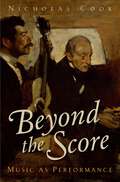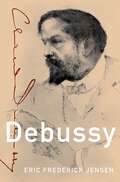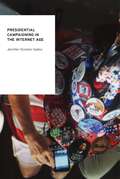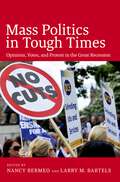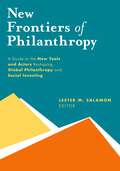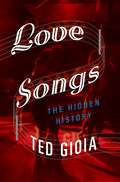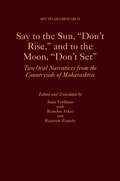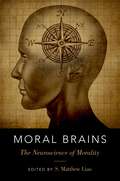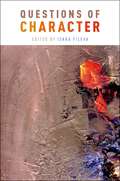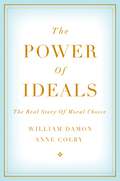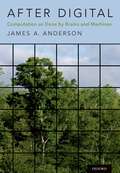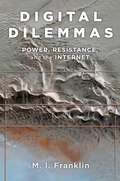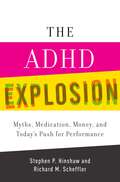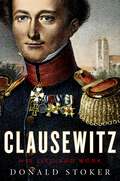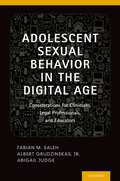- Table View
- List View
Beyond the Score: Music as Performance
by Nicholas CookIn Beyond the Score: Music as Performance, author Nicholas Cook supplants the traditional musicological notion of music as writing, asserting instead that it is as performance that music is loved, understood, and consumed. This book reconceives music as an activity through which meaning is produced in real time, as Cook rethinks familiar assumptions and develops new approaches. Focusing primarily but not exclusively on the Western 'art' tradition, Cook explores perspectives that range from close listening to computational analysis, from ethnography to the study of recordings, and from the social relations constructed through performance to the performing (and listening) body. In doing so, he reveals not only that the notion of music as text has hampered academic understanding of music, but also that it has inhibited performance practices, placing them in a textualist straightjacket. Beyond the Score has a strong historical emphasis, touching on broad developments in twentieth-century performance style and setting them into their larger cultural context. Cook also investigates the relationship between recordings and performance, arguing that we do not experience recordings as mere reproductions of a performance but as performances in their own right. Beyond the Score is a comprehensive exploration of new approaches and methods for the study of music as performance, and will be an invaluable addition to the libraries of music scholars - including musicologists, music theorists, and music cognition scholars - everywhere. Publication of this book was supported by the AMS 75 PAYS Endowment of the American Musicological Society, funded in part by the National Endowment for the Humanities and the Andrew W. Mellon Foundation.
Debussy (Master Musicians Series)
by Eric Frederick JensenNearly one hundred years after the death of its composer, the music of Claude Debussy has lost none of its breadth of appeal. With the rare ability to entice listeners on many levels, at its heart lies an engaging simplicity-one which defies traditional analysis and lends mystery to what ultimately is an extremely refined and highly personal approach to composition. Equally fascinating is Debussy's often contradictory personality--at times elusive, but always centered on his devotion to music and his ambition to create a name for himself unlike any other. Author Eric Frederick Jensen provides new insight to the man and the music in this authoritative biography. Although born into poverty, and a failure as a piano student at the Paris Conservatoire, Debussy became the most famous French composer of his day, known for his culture and refinement. His revolutionary music baffled critics but was embraced by audiences. Debussy's scandalous personal life stirred up as much controversy as his music, and his notoriety proved more harmful to his career than the unusual nature of his compositions. Jensen also explores Debussy's relationship to the arts and his career as a music critic. Debussy drew on all of the arts in his development as a composer, including poetry and painting, and his fascination with the arts has often led to his being classified as an Impressionist or Symbolist, two claims which Jensen debunks. One of the finest music critics of his time, Debussy's reviews reveal a great deal not only about his musical taste, but also about what he felt the role and function of music should be. Debussy brings together the most recent biographical research, including a revised catalogue of Debussy's compositions and the first complete edition of his correspondence. With separate, chronological sections on his life and music, Debussy is accessible to the general reader who wishes to focus on his life and personality, while providing detailed discussion of the music to musicians and students.
Presidential Campaigning in the Internet Age (Oxford Studies in Digital Politics)
by Jennifer Stromer-GalleyAs the plugged-in presidential campaign has arguably reached maturity, Presidential Campaigning in the Internet Age challenges popular claims about the democratizing effect of Digital Communication Technologies (DCTs). Analyzing campaign strategies, structures, and tactics from the past five presidential election cycles, Stromer-Galley reveals how, for all their vaunted inclusivity and tantalizing promise of increased two-way communication between candidates and the individuals who support them, DCTs have done little to change the fundamental dynamics of campaigns. The expansion of new technologies has presented candidates with greater opportunities to micro-target potential voters, cheaper and easier ways to raise money, and faster and more innovative ways to respond to opponents. The need for communication control and management, however, has made campaigns slow and loathe to experiment with truly interactive internet communication technologies. Citizen involvement in the campaign historically has been and, as this book shows, continues to be a means to an end: winning the election for the candidate. For all the proliferation of apps to download, polls to click, videos to watch, and messages to forward, the decidedly undemocratic view of controlled interactivity is how most campaigns continue to operate. Contributing to the field a much-needed historical understanding of the shifting communication practices of presidential campaigns, Presidential Campaigning in the Internet Age examines election cycles from 1996, when the World Wide Web was first used for presidential campaigning, through 2012, when practices were being tuned to perfection using data analytics for carefully targeting and mobilizing particular voter segments. As the book charts changes in internet communication technologies, it shows how, even as campaigns have moved responsively from a mass mediated to a networked paradigm, and from fundraising to organizing, the possibilities these shifts in interactivity seem to promise for citizen input and empowerment remain much farther than a click away.
Mass Politics In Tough Times C: Opinions, Votes, And Protest In The Great Recession
by Nancy Bermeo Larry M. BartelsMass Politics in Tough Times: Opinions, Votes, and Protest in the Great Recession
by Nancy Bermeo Larry M. BartelsThe impact of the Great Depression on politics in the 1930s was both transformative and shocking. The role of government in America was forever transformed, and across Europe socialist, communist, and fascist parties saw their support skyrocket. Most famously, the National Socialists seized power in Germany in 1933, setting off a chain of events that led to the greatest conflagration in world history. The recent Great Recession has not been as severe as the Great Recession, but it has been severe enough, producing a half decade of negative and/or slow growth across the advanced industrial world. Yet the response by voters has been extraordinarily muted considering the circumstances. Why is this? In Mass Politics in Tough Times, the eminent political scientists Larry Bartels and Nancy Bermeo have gathered a group of leading scholars to analyze the political responses to the Great Recession in the US, Western Europe, and East-Central Europe. In contrast to works that focus on policy responses to the Recession, they examine how ordinary voters have responded. In almost every country, most voters have not shifted their allegiance to either far left or far right parties. Instead, they've continued to act as they have in more normal times: vote based on their own personal circumstances and punish the incumbents who were on watch when the bad turn occurred regardless of whether they were center-left or center-right. In some countries, electoral trends that existed before the Recession have continued. The US, for instance, saw no real increase in popular support for an expanded welfare state. In fact, the anti-regulatory right, which gained strength before the Recession occurred, experienced a series of victories in Wisconsin after 2008. Interestingly, states that had strong welfare systems have seen the least political realignment. As the contributors show, ordinary voters tend to vote based on their own experiences, and those in expansive welfare states have been buffered from the harshest effects of the Recession. That said, states with weaker welfare systems--e.g., Greece--have seen significant political turmoil. Moreover, there have been a small number of cases of popular radicalization, and the contributors have been able to isolate the cause: when voters can establish a clear and direct connection between the actions of political elites and economic hardship, they will throw their support to protest parties on the right and left. Ultimately, though, the picture is one of relatively stoic acceptance of the downturn by the majority of publics. Featuring an impressive range of cases, this will stand as the most comprehensive scholarly account of the Great Recession's impact on political behavior in advanced economies.
New Frontiers Of Philanthropy: A Guide To The New Tools And New Actors That Are Reshaping Global Philanthropy And Social Investing
by Lester M. SalamonNew Frontiers of Philanthropy: A Guide to the New Tools and New Actors that Are Reshaping Global Philanthropy and Social Investing
by Lester M. SalamonThe resources of both governments and traditional philanthropy are either barely growing or in decline, yet the problems of poverty, ill-health, and environmental degradation balloon daily. It is therefore increasingly clear that we urgently need new models for financing and promoting social and environmental objectives. Fortunately, a significant revolution appears to be underway on the frontiers of philanthropy and social investing, tapping not only philanthropy, but also private investment capital, and providing at least a partial response to this dilemma. This book examines the new actors and new tools that form the heart of this revolution, and shows how they are reshaping the way we go about supporting solutions to social and environmental problems throughout the world. With contributions from leading experts in the field, New Frontiers of Philanthropy provides a comprehensive analysis of the many new institutions that have surfaced on this new frontier of philanthropy and social investment; the new tools and instruments these institutions are bringing to bear; the challenges that these actors and tools still encounter; and the steps that are needed to maximize their impact. The result is a powerful and accessible guide to developments that are already bringing significant new resources into efforts to solve the world's problems of poverty, ill-health, and environmental degradation; unleashing new energies and new sources of ingenuity for social and environmental problem-solving; and generating new hope in an otherwise dismal scenario of lagging resources and resolve. Investors, philanthropists, social entrepreneurs, nonprofit leaders, business executives, government officials, and students the world over will find much to build on in these pages.
Love Songs: The Hidden History
by Ted GioiaThe love song is timeless. From its beginnings, it has been shaped by bohemians and renegades, slaves and oppressed minorities, prostitutes, immigrants and other excluded groups. But what do we really know about the origins of these intimate expressions of the heart? And how have our changing perceptions about topics such as sexuality and gender roles changed our attitudes towards these songs? In Love Songs: The Hidden History, Ted Gioia uncovers the unexplored story of the love song for the first time. Drawing on two decades of research, Gioia presents the full range of love songs, from the fertility rites of ancient cultures to the sexualized YouTube videos of the present day. The book traces the battles over each new insurgency in the music of love--whether spurred by wandering scholars of medieval days or by four lads from Liverpool in more recent times. In these pages, Gioia reveals that the tenderest music has, in different eras, driven many of the most heated cultural conflicts, and how the humble love song has played a key role in expanding the sphere of individualism and personal autonomy in societies around the world. Gioia forefronts the conflicts, controversies, and the battles over censorship and suppression spurred by such music, revealing the outsiders and marginalized groups that have played a decisive role in shaping our songs of romance and courtship, and the ways their innovations have led to reprisals and strife. And he describes the surprising paths by which the love song has triumphed over these obstacles, and emerged as the dominant form of musical expression in modern society.
Love Songs: The Hidden History
by Ted GioiaThe love song is timeless. From its beginnings, it has been shaped by bohemians and renegades, slaves and oppressed minorities, prostitutes, immigrants and other excluded groups. But what do we really know about the origins of these intimate expressions of the heart? And how have our changing perceptions about topics such as sexuality and gender roles changed our attitudes towards these songs? In Love Songs: The Hidden History, Ted Gioia uncovers the unexplored story of the love song for the first time. Drawing on two decades of research, Gioia presents the full range of love songs, from the fertility rites of ancient cultures to the sexualized YouTube videos of the present day. The book traces the battles over each new insurgency in the music of love--whether spurred by wandering scholars of medieval days or by four lads from Liverpool in more recent times. In these pages, Gioia reveals that the tenderest music has, in different eras, driven many of the most heated cultural conflicts, and how the humble love song has played a key role in expanding the sphere of individualism and personal autonomy in societies around the world. Gioia forefronts the conflicts, controversies, and the battles over censorship and suppression spurred by such music, revealing the outsiders and marginalized groups that have played a decisive role in shaping our songs of romance and courtship, and the ways their innovations have led to reprisals and strife. And he describes the surprising paths by which the love song has triumphed over these obstacles, and emerged as the dominant form of musical expression in modern society.
Say to the Sun, "Don't Rise," and to the Moon, "Don't Set": Two Oral Narratives from the Countryside of Maharashtra (South Asia Research)
by Anne FeldhausPastoralist traditions have long been extraordinarily important to the social, economic, political, and cultural life of western India. The Marathi-language oral literature of the Dhangar shepherds is not only one of the most important elements of the traditional cultural life of its region, but also a treasure of world literature. This volume presents translations of two lively and well-crafted examples of the ovi, a genre typical of the oral literature of Dhangars. The two ovis in the volume narrate the stories of Biroba and Dhuloba, two of these shepherds' most important gods. Each of the ovis tells an elaborate story of the birth of the god-a miraculous and complicated process in both cases-and of the struggles each one goes through in order to find and win his bride. The extensive introduction provides a literary analysis of the ovis and discusses what they reveal about the cosmology, geography, society, and political arrangements of their performers' world, as well as about the performers' views of pastoralists and women.
Moral Brains: The Neuroscience of Morality
by S. Matthew LiaoIn the last fifteen years, there has been significant interest in studying the brain structures involved in moral judgments using novel techniques from neuroscience such as functional magnetic resonance imaging (fMRI). Many people, including a number of philosophers, believe that results from neuroscience have the potential to settle seemingly intractable debates concerning the nature, practice, and reliability of moral judgments. This has led to a flurry of scientific and philosophical activities, resulting in the rapid growth of the new field of moral neuroscience. There is now a vast array of ongoing scientific research devoted towards understanding the neural correlates of moral judgments, accompanied by a large philosophical literature aimed at interpreting and examining the methodology and the results of this research. This is the first volume to take stock of fifteen years of research of this fast-growing field of moral neuroscience and to recommend future directions for research. It features the most up-to-date research in this area, and it presents a wide variety of perspectives on this topic.
Questions of Character
This collection features 26 new essays on character from first-rate scholars in philosophy, psychology, economics, and law. The essays are elegantly written and combine forceful argumentation with original ideas on a wide range of questions, such as:"Is Aristotle's theory of character a moral theory?," "Are character traits in tension with personal autonomy", "How do traits differ from mental disorders?," "What is the role of gossip in character attribution?," and "Can businessmen be virtuous?" The chapters are organized thematically into 5 sections, each prefaced by its own special introduction. In the introductions, the editor brings out often unexpected connections among different lines of argument pursued by the authors and raises important questions for further discussion. The collection as a whole offers students of character a unique opportunity to engage with some of the best contemporary work on the topic.
The Power of Ideals: The Real Story of Moral Choice
by William Damon Anne ColbyCynicism often seems a smarter choice than idealism. There are reasons for this. Politicians have disappointed us time and again; trusted institutions have proven to be self-serving and corrupt; hopes for lasting world peace repeatedly have been dashed; and social inequities persist and increase, unabated by even the grandest of charitable efforts. It is now considered foolish to think that people can be counted on to rise above their narrow self-interests to serve the broader good, or to tell the truth if it does not reflect well on the self. Supporting this bleak view of the human condition is a moral psychology that has taken increasingly cynical turns in recent years. Famous studies have shown that we have an almost unlimited potential for cruelty when placed in the wrong situations. The Power of Ideals presents a different vision, supported by a different kind of evidence. It examines the lives and work of six 20th century moral leaders who pursued moral causes ranging from world peace to social justice and human rights. Using these six cases to illustrate how people can make choices guided by their moral convictions, rather than by base emotion or social pressures, authors William Damon and Anne Colby explore the workings of three virtues: inner truthfulness, humility, and faith. Through their portrayal of the noble lives of moral leaders, the authors argue that all of us--with ordinary lives--can exercise control over important life decisions and pursue ideals that we believe in.
The Power of Ideals: The Real Story of Moral Choice
by William Damon Anne ColbyCynicism often seems a smarter choice than idealism. There are reasons for this. Politicians have disappointed us time and again; trusted institutions have proven to be self-serving and corrupt; hopes for lasting world peace repeatedly have been dashed; and social inequities persist and increase, unabated by even the grandest of charitable efforts. It is now considered foolish to think that people can be counted on to rise above their narrow self-interests to serve the broader good, or to tell the truth if it does not reflect well on the self. Supporting this bleak view of the human condition is a moral psychology that has taken increasingly cynical turns in recent years. Famous studies have shown that we have an almost unlimited potential for cruelty when placed in the wrong situations. The Power of Ideals presents a different vision, supported by a different kind of evidence. It examines the lives and work of six 20th century moral leaders who pursued moral causes ranging from world peace to social justice and human rights. Using these six cases to illustrate how people can make choices guided by their moral convictions, rather than by base emotion or social pressures, authors William Damon and Anne Colby explore the workings of three virtues: inner truthfulness, humility, and faith. Through their portrayal of the noble lives of moral leaders, the authors argue that all of us--with ordinary lives--can exercise control over important life decisions and pursue ideals that we believe in.
After Digital: Computation as Done by Brains and Machines
by James A. AndersonCurrent computer technology doubles in in power roughly every two years, an increase called "Moore's Law." This constant increase is predicted to come to an end soon. Digital technology will change. Although digital computers dominate today's world, there are alternative ways to "compute" which might be better and more efficient than digital computation. After Digital looks at where the field of computation began and where it might be headed, and offers predictions about a collaborative future relationship between human cognition and mechanical computation. James A. Anderson, a pioneer of biologically inspired neural nets, presents two different kinds of computation-digital and analog--and gives examples of their history, function, and limitations. A third, the brain, falls somewhere in between these two forms, and is suggested as a computer architecture that is more capable of performing some specific important cognitive tasks-perception, reasoning, and intuition, for example- than a digital computer, even though the digital computer is constructed from far faster and more reliable basic elements. Anderson discusses the essentials of brain hardware, in particular, the cerebral cortex, and how cortical structure can influence the form taken by the computational operations underlying cognition. Topics include association, understanding complex systems through analogy, formation of abstractions, the biology of number and its use in arithmetic and mathematics, and computing across scales of organization. These applications, of great human interest, also form the goals of genuine artificial intelligence. After Digital will appeal to a broad cognitive science community, including computer scientists, philosophers, psychologists, and neuroscientists, as well as the curious science layreader, and will help to understand and shape future developments in computation.
After Digital: Computation as Done by Brains and Machines
by James A. AndersonCurrent computer technology doubles in in power roughly every two years, an increase called "Moore's Law." This constant increase is predicted to come to an end soon. Digital technology will change. Although digital computers dominate today's world, there are alternative ways to "compute" which might be better and more efficient than digital computation. After Digital looks at where the field of computation began and where it might be headed, and offers predictions about a collaborative future relationship between human cognition and mechanical computation. James A. Anderson, a pioneer of biologically inspired neural nets, presents two different kinds of computation-digital and analog--and gives examples of their history, function, and limitations. A third, the brain, falls somewhere in between these two forms, and is suggested as a computer architecture that is more capable of performing some specific important cognitive tasks-perception, reasoning, and intuition, for example- than a digital computer, even though the digital computer is constructed from far faster and more reliable basic elements. Anderson discusses the essentials of brain hardware, in particular, the cerebral cortex, and how cortical structure can influence the form taken by the computational operations underlying cognition. Topics include association, understanding complex systems through analogy, formation of abstractions, the biology of number and its use in arithmetic and mathematics, and computing across scales of organization. These applications, of great human interest, also form the goals of genuine artificial intelligence. After Digital will appeal to a broad cognitive science community, including computer scientists, philosophers, psychologists, and neuroscientists, as well as the curious science layreader, and will help to understand and shape future developments in computation.
Digital Dilemmas: Power, Resistance, and the Internet
by M.I. FranklinDigital Dilemmas looks at the dynamics of power and resistance surrounding the internet. It focuses on how publics, nation-states, and multilateral institutions are being continually reinvented in local and global decision-making domains that are accessed and controlled by a relative few. Importantly it unpacks the ways in which computer-mediated power relations play out as "on the ground" and "cyberspatial" practices and discourses that collude and collide with one another at the personal, community, and transnational level. Case studies include homelessness and the internet, rights-based advocacy for the online environment at the United Nations, and how the ongoing battle between proprietary and open source software designs affects ordinary people and policy-making. The result is an innovative and groundbreaking critique of the way new paradigms of power and resistance forged online reshape traditional power hierarchies offline, at home and abroad.
The ADHD Explosion: Myths, Medication, Money, and Today's Push for Performance
by Stephen P. Hinshaw Richard M. SchefflerAttention-deficit/hyperactivity disorder (ADHD) is one of the most controversial and misunderstood medical conditions today. With skyrocketing rates of diagnosis and medication treatment, it has generated a firestorm of controversy. Alarming questions have been raised about ADHD in recent years, including: *Why are one in nine children and adolescents in the U.S. now diagnosed with ADHD, with projected rates still rising? *Why are nearly 70% of those diagnosed with ADHD prescribed medication? *What is causing the fast-rising diagnosis and medication of adults? And why are over a quarter of all college students using stimulants for academic performance? *In some southern states, why are boys over 9 years old diagnosed at rates of almost one in three? *Can we trust the stories we read and hear about ADHD, even in major media outlets? *What is driving the current ADHD explosion--is it parents, doctors, schools, culture, the healthcare system, or Big Pharma? And will it end? Stephen Hinshaw, a distinguished psychologist, and Richard Scheffler, an eminent health economist, uniquely blend clinical wisdom, current science, medical and school policy, and global trends to debunk myths and set the record straight in The ADHD Explosion. They describe the origins of ADHD and its huge costs to society; the science behind its causes as well as medication and behavioral treatment; and the variation in diagnosis and treatment across the U.S. Dealing directly with stimulants as "smart pills," they describe the epidemic of medicalization, arguing that accurate diagnosis and well-monitored care could ease the staggering economic burden linked to ADHD. In innovative ways, they unravel the many poignant issues facing children, teachers, clinicians, and family members who contend with ADHD each day. The recommendations they make can improve the quality of life for those touched by ADHD and potentially improve the productivity and safety of all society.
Clausewitz: His Life and Work
by Donald StokerCarl von Clausewitz's masterwork, On War, is generally considered the greatest text on military theory ever written. Clausewitz is a touchstone for the field today, and is read by scholars, students, and military personnel around the world. And yet to Clausewitz himself, far more important than achieving recognition for his scholarly and theoretical contributions was achieving glory on the field of battle-winning renown not with his pen but with his sword. Military historian Donald Stoker's perceptive biography of Carl von Clausewitz moves skillfully between Clausewitz's career as a soldier and his work as a theoretician and author, exploring the composition of On War and other works while also emphasizing the many military engagements in which Clausewitz fought. Though Clausewitz certainly spilled his share of ink, he also spilled blood--his as well as that of the enemy. As an officer in the Prussian army, Clausewitz fought in battles from Jena-Auerstedt to Waterloo, as well as the battle of Borodino while serving the Russians. Stoker takes readers through the heat of these battles, providing historical overview and discussing each engagement in detail. Rich context is provided by Clausewitz himself, who wrote abundant letters to his wife and friends throughout his life, and from which Stoker draws extensively. Clausewitz argues for the centrality of Clausewitz's work as a soldier, but it does not neglect his historical achievements in military theory. Stoker unpacks each of Clausewitz's significant works, considering their influences and describing the circumstances around their composition. The interplay between the biographical details of Clausewitz's life and the arguments put forth in his written works allows for a deeper understanding of these familiar texts, and Stoker's insightful commentary adds depth to the discussion. The result is an absorbing reassessment of both the man and his legacy, and a significant contribution to the study of Clausewitz and his place in today's military and political landscape.
Clausewitz: His Life and Work
by Donald StokerCarl von Clausewitz's masterwork, On War, is generally considered the greatest text on military theory ever written. Clausewitz is a touchstone for the field today, and is read by scholars, students, and military personnel around the world. And yet to Clausewitz himself, far more important than achieving recognition for his scholarly and theoretical contributions was achieving glory on the field of battle-winning renown not with his pen but with his sword. Military historian Donald Stoker's perceptive biography of Carl von Clausewitz moves skillfully between Clausewitz's career as a soldier and his work as a theoretician and author, exploring the composition of On War and other works while also emphasizing the many military engagements in which Clausewitz fought. Though Clausewitz certainly spilled his share of ink, he also spilled blood--his as well as that of the enemy. As an officer in the Prussian army, Clausewitz fought in battles from Jena-Auerstedt to Waterloo, as well as the battle of Borodino while serving the Russians. Stoker takes readers through the heat of these battles, providing historical overview and discussing each engagement in detail. Rich context is provided by Clausewitz himself, who wrote abundant letters to his wife and friends throughout his life, and from which Stoker draws extensively. Clausewitz argues for the centrality of Clausewitz's work as a soldier, but it does not neglect his historical achievements in military theory. Stoker unpacks each of Clausewitz's significant works, considering their influences and describing the circumstances around their composition. The interplay between the biographical details of Clausewitz's life and the arguments put forth in his written works allows for a deeper understanding of these familiar texts, and Stoker's insightful commentary adds depth to the discussion. The result is an absorbing reassessment of both the man and his legacy, and a significant contribution to the study of Clausewitz and his place in today's military and political landscape.
Adolescent Sexual Behavior in the Digital Age
by Fabian M. Saleh Albert J. Grudzinskas, Jr., JD Abigail M. JudgeAdolescent Sexual Behavior in the Digital Age: Considerations for Clinicians, Legal Professionals and Educators
by Fabian M. Saleh Albert J. Grudzinskas, Jr., JD Abigail M. JudgeThe nexus between the digital revolution and adolescent sexual behavior has posed significant challenges to mental health practitioners, attorneys, and educators. These digital technologies may facilitate dangerous behaviors and serious consequences for some youth. Adolescent Sexual Development in the Digital Age considers adolescent sexual behavior in both clinical and legal contexts and provides a basis for clinicians, legal professionals, educators, policy makers, parents and the general public to understand the impact that technology has on human growth and development. The book's contributing authors are leading authorities in adolescent development, law, and ethics, fostering an interdisciplinary dialogue within the text. New technology poses many opportunities for both normal and risky sexual behavior in youth; including "sexting," social networking, cyber-sexual harassment, commercial exploitation of children, and child pornography. Beyond just cataloging the various technologies impacting sexual behavior, this volume offers guidance and strategies for addressing the issues created by the digital age.
